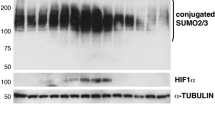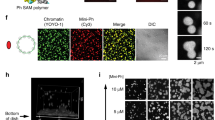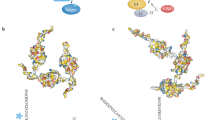Abstract
Post-translational modification of proteins by the ubiquitin-like molecule SUMO (sumoylation) regulates their subcellular localization and affects their functional properties in vitro1,2, but the physiological function of sumoylation in multicellular organisms is largely unknown. Here, we show that the C. elegans Polycomb group (PcG) protein SOP-2 interacts with the SUMO-conjugating enzyme UBC-9 through its evolutionarily conserved SAM domain. Sumoylation of SOP-2 is required for its localization to nuclear bodies in vivo and for its physiological repression of Hox genes. Global disruption of sumoylation phenocopies a sop-2 mutation by causing ectopic Hox gene expression and homeotic transformations. Chimeric constructs in which the SOP-2 SAM domain is replaced with that derived from fruit fly or mammalian PcG proteins, but not those in which the SOP-2 SAM domain is replaced with the SAM domains of non-PcG proteins, confer appropriate in vivo nuclear localization and Hox gene repression. These observations indicate that sumoylation of PcG proteins, modulated by their evolutionarily conserved SAM domain, is essential to their physiological repression of Hox genes.
This is a preview of subscription content, access via your institution
Access options
Subscribe to this journal
Receive 12 print issues and online access
$259.00 per year
only $21.58 per issue
Buy this article
- Purchase on SpringerLink
- Instant access to full article PDF
Prices may be subject to local taxes which are calculated during checkout




Similar content being viewed by others
References
Seeler, J.S. & Dejean, A. SUMO: of branched proteins and nuclear bodies. Oncogene 20, 7243– 7249 (2001).
Wilson, V.G. & Rangasamy, D. Intracellular targeting of proteins by sumoylation. Exp. Cell Res. 271, 57– 65 (2001).
Zhang, H. et al. Global regulation of Hox gene expression in C. elegans by a SAM domain protein. Dev. Cell 4, 903– 915 (2003).
Netter, S., Faucheux, M. & Theodore, L. Developmental dynamics of a polyhomeotic-EGFP fusion in vivo. DNA Cell Biol. 20, 483– 492 (2001).
Best, J.L. et al. SUMO-1 protease-1 regulates gene transcription through PML. Mol. Cell 10, 843– 855 (2002).
Ross, S., Best, J.L., Zon, L.I. & Gill, G. SUMO-1 modification represses Sp3 transcriptional activation and modulates its subnuclear localization. Mol. Cell 10, 831– 842 (2002).
Bhaskar, V., Valentine, S.A. & Courey, A.J. A functional interaction between dorsal and components of the Smt3 conjugation machinery. J. Biol. Chem. 275, 4033– 4040 (2000).
Epps, J.L. & Tanda, S. The Drosophila semushi mutation blocks nuclear import of bicoid during embryogenesis. Curr. Biol. 8, 1277– 1280 (1998).
Emmons, S.W. Cell fate determination in Caenorhabditis elegans ray develpment. in Cell Lineage and Fate Determination (ed. S.A. Moody) 139– 155 (Academic, San Diego, 1999).
Jones, D., Crowe, E., Stevens, T.A. & Candido, E.P. Functional and phylogenetic analysis of the ubiquitylation system in Caenorhabditis elegans: ubiquitin-conjugating enzymes, ubiquitin-activating enzymes, and ubiquitin-like proteins. Genome Biol. 3(1), research0002.1– 0002.15 (2002).
Ferreira, H.B., Zhang, Y.H., Zhao, C. & Emmons, S.W. Patterning of Caenorhabditis elegans posterior structures by the Abdominal-B homolog, egl-5. Dev. Biol. 207, 215– 228 (1999).
Kim, C.A. et al. Polymerization of the SAM domain of TEL in leukemogenesis and transcriptional repression. EMBO J. 20, 4173– 4182 (2001).
Kim, C.A., Gingery, M., Pilpa, R.M. & Bowie, J.U. The SAM domain of polyhomeotic forms a helical polymer. Nat. Struct. Biol. 9, 453– 457 (2002).
Chakrabarti, S.R., Sood, R., Nandi, S. & Nucifora, G. Posttranslational modification of TEL and TEL/AML1 by SUMO-1 and cell-cycle-dependent assembly into nuclear bodies. Proc. Natl. Acad. Sci. USA 97, 13281– 13285 (2000).
Zhong, S., Salomoni, P. & Pandolfi, P.P. The transcriptional role of PML and the nuclear body. Nat. Cell Biol. 2, E85– E90 (2000).
Kim, Y.H., Choi, C.Y. & Kim, Y. Covalent modification of the homeodomain-interacting protein kinase 2 (HIPK2) by the ubiquitin-like protein SUMO-1. Proc. Natl. Acad. Sci. USA 96, 12350– 12355 (1999).
Sachdev, S. et al. PIASy, a nuclear matrix-associated SUMO E3 ligase, represses LEF1 activity by sequestration into nuclear bodies. Genes Dev. 15, 3088– 3103 (2001).
Apionishev, S., Malhotra, D., Raghavachari, S., Tanda, S. & Rasooly, R.S. The Drosophila UBC9 homologue lesswright mediates the disjunction of homologues in meiosis I. Genes Cells 6, 215– 224 (2001).
Brenner, S. The genetics of Caenorhabditis elegans. Genetics 77, 71– 94 (1974).
Fire, A. et al. Potent and specific genetic interference by double-stranded RNA in Caenorhabditis elegans. Nature 391, 806– 811 (1998).
Acknowledgements
This work was supported by grants from the US National Institutes of Health (to H.Z., S.v.d.H. and D.A.H.).
Author information
Authors and Affiliations
Corresponding author
Ethics declarations
Competing interests
The authors declare no competing financial interests.
Rights and permissions
About this article
Cite this article
Zhang, H., Smolen, G., Palmer, R. et al. SUMO modification is required for in vivo Hox gene regulation by the Caenorhabditis elegans Polycomb group protein SOP-2. Nat Genet 36, 507–511 (2004). https://doi.org/10.1038/ng1336
Received:
Accepted:
Published:
Issue date:
DOI: https://doi.org/10.1038/ng1336
This article is cited by
-
SUMO promotes longevity and maintains mitochondrial homeostasis during ageing in Caenorhabditis elegans
Scientific Reports (2020)
-
Phase separation of the C. elegans Polycomb protein SOP-2 is modulated by RNA and sumoylation
Protein & Cell (2020)
-
Dynamic SUMO modification regulates mitotic chromosome assembly and cell cycle progression in Caenorhabditis elegans
Nature Communications (2014)
-
A new world of Polycombs: unexpected partnerships and emerging functions
Nature Reviews Genetics (2013)
-
Overexpression of SUMO perturbs the growth and development of Caenorhabditis elegans
Cellular and Molecular Life Sciences (2011)



